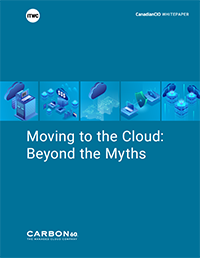
The current COVID-19 global pandemic could provide the impetus for some companies to advance their digital transformations – but they’re more likely to succeed if they apply customer-centric design-thinking, CIOs said at a recent CanadianCIO Executive Forum in Toronto sponsored by Wipro Limited Canada.
“I’ve said don’t waste a good crisis because when people get desperate for results, you do it,” said Jim Love, IT World Canada (ITWC) CIO and a co-host for the event. “Sometimes it takes a crisis to turn people’s mindset around.”
In essence, Love noted, a digital transformation should be about creating a great customer experience based on detailed customer knowledge, or personas, and analyzing the customer journey.
Truly effective design-thinking takes into account all stakeholders, added co-host Amit Majithia, the recently appointed Vice-President and Country Head for Wipro Limited Canada, a division of India-based IT giant Wipro Limited.
In a market where almost all companies are evolving into technology firms, design-thinking can also help CIOs convince CEOs that a digital transformation can be a real competitive differentiator – and means more than jumping on the latest tech gimmick.
“It’s not just about customers, but employees,” Majithia told the group. “How are they going to work in the new environment? Then the supply chain – how do you work with them? You have to look at all aspects of your partners and employees to collaboratively digitize with them.”
As an IT firm dominated by logical, left-brain-oriented engineers, Majithia said, Wipro did not excel in design-thinking until 2015, when it acquired Copenhagen-based Designit, one of the world’s largest, privately-held design firms.
Sadly, said Love, some organizations stumble out of the gate on their DX journey by misunderstanding their core clientele. “You’d be surprised,” he joked, “how many companies are actually afraid to meet their customers.”
A CIO with a mortgage financing firm said it took an in-depth “customer immersion” process to shatter some of the misconceptions his company had about its clients. The sessions involved eight to 10 customers from around the country meeting with employees in various departments.
“What we learned,” he said, “was that the typical customer is not always who you think they are. You create personas, but you actually have to meet the real people to see how they match and bake that into the product. We’re still on this journey.”
A truly transformative digital shift may require a change in corporate culture, including adopting a common language that reflects the new reality. Two CIOs said that began at their companies by choosing the right term for customer.
“Our persona was the ‘borrower,’” said the mortgage firm CIO. “But we discovered they hate that. Now we call them customers. Nobody wants to be thought of as a borrower.” At a national food services franchise, they banned the word customer and now call their patrons “guests.”
Creating a common vocabulary becomes critically important in merger or acquisition scenarios, said Love. “So many of our disagreements,” he observed, “are just the words we use.”
In the spirit of agile development, several CIOs agreed that a successful digital transformation also requires a culture that embraces failure. In that respect, millennial employees may be less fearful of losing status. “The strength they bring is challenging the status quo,” said Majithia. “I think that’s where they add a lot of value.”
One CIO said that risk-averse organizations might have more incentive to attempt a digital transformation if they explore the Canada Revenue Agency’s Scientific Research and Experimental Development Tax Credit. The SR&ED or SHRED program offers Canadian-controlled private corporations an investment tax credit of 35 per cent up to the first $3 million in qualified expenses for innovative projects carried out in Canada.
For many companies, one of the biggest barriers to effectively executing a digital transformation is recruiting the right talent in the numbers needed. Retraining the existing team may be the only option, said Majithia. “Most employees,” he added, “are getting it now that if they aren’t retrained, then they become irrelevant.”
He said Wipro has addressed the talent shortage to some extent through TopGear, its internal crowdsourcing platform, which was built to enable Wipro project managers to tap into Wipro employees outside of their teams to complete work.
Would you recommend this article?
We’d love to hear your opinion about this or any other story you read in our publication. Click this link to send me a note →
Jim Love, Chief Content Officer, IT World Canada
Related Download
 Sponsor: Carbon60
Sponsor: Carbon60
Moving to the Cloud: Beyond the Myths
Get on the road to cloud success by moving past the myths around it.
Register Now
Share This Story, Choose Your Platform!
Related Posts
Recent Posts
- The government grant landscape is changing; how does IT fit in?
- The government wants CATA’s advice on how to improve SR&ED funding
- Impact of COVID-19 on the SR&ED Tax Credit
- Everything you must know about scientific research and experimental growth
- As Liberals tout ‘innovation agenda,’ CRA keeps scaling back SR&ED credits: CATA


